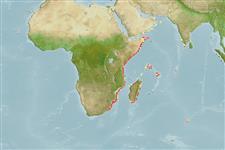Holocéphales (chimères) (chimaeras) >
Chimaeriformes (Chimaeras) >
Chimaeridae (Shortnose chimaeras or ratfishes)
Etymology: Hydrolagus: hydro-, combining form of hydor (Gr.), water; lagos (Gr.), hare, i.e., “water rabbit,” probably referring to three pairs of tooth plates, which tend to protrude from the mouth like a rabbit’s incisors. (See ETYFish); africanus: -anus (L.), belonging to: Africa, described from deep water off the KwaZulu-Natal South Coast of South Africa. (See ETYFish).
Environment: milieu / climate zone / depth range / distribution range
Écologie
marin bathydémersal; profondeur 421 - 750 m (Ref. 3181). Deep-water
Western Indian Ocean: off Kenya, Mozambique and Natal, South Africa.
Taille / Poids / Âge
Maturity: Lm ? range ? - ? cm
Max length : 67.0 cm TL mâle / non sexé; (Ref. 3181)
Description synthétique
Clés d'identification | Morphologie | Morphométrie
Épines dorsales (Total) : 1; Épines anales: 0; Rayons mous anaux: 0. A shortnose chimaera with the dorsal fin spine longer than the head; 2nd dorsal fin with distinct concavity in the middle (Ref. 5578).
Feeds on ophiuroids (Ref. 27637). Oviparous (Ref. 205). Eggs are encased in horny shells (Ref. 205).
Life cycle and mating behavior
Maturities | Reproduction | Spawnings | Egg(s) | Fecundities | Larves
Compagno, L.J.V., 1986. Chimaeridae. p. 144-145. In M.M. Smith and P.C. Heemstra (eds.) Smiths' sea fishes. Springer-Verlag, Berlin. (Ref. 3181)
Statut dans la liste rouge de l'IUCN (Ref. 130435)
Utilisations par l'homme
Pêcheries: sans intérêt
Outils
Articles particuliers
Télécharger en XML
Sources Internet
Estimates based on models
Preferred temperature (Ref.
123201): 8.9 - 11.4, mean 9.7 °C (based on 16 cells).
Phylogenetic diversity index (Ref.
82804): PD
50 = 0.5000 [Uniqueness, from 0.5 = low to 2.0 = high].
Bayesian length-weight: a=0.00282 (0.00118 - 0.00673), b=3.10 (2.89 - 3.31), in cm total length, based on LWR estimates for this (Sub)family-body shape (Ref.
93245).
Niveau trophique (Ref.
69278): 4.1 ±0.60 se; based on food items.
Résilience (Ref.
120179): Faible, temps minimum de doublement de population : 4,5 à 14 années (Assuming Fec <100).
Fishing Vulnerability (Ref.
59153): Moderate to high vulnerability (47 of 100).
